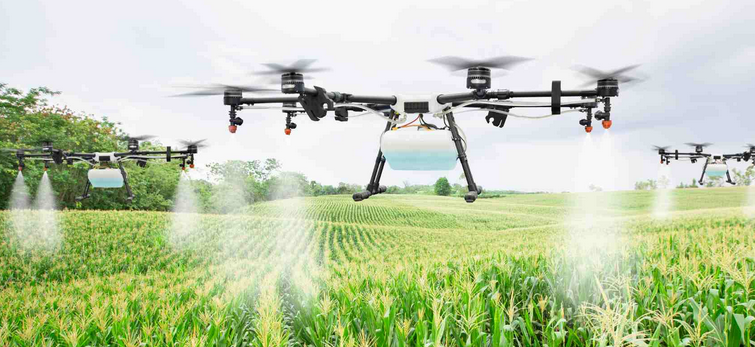|
Getting your Trinity Audio player ready...
|
In an era marked by population growth, climate change, and the need for sustainable farming practices, precision agriculture emerges as a game-changing approach to food production. By harnessing advanced technologies and data-driven insights, precision agriculture revolutionizes the way we cultivate crops and raise livestock, enhancing efficiency, reducing waste, and promoting environmental stewardship.

Introduction: Precision Agriculture Unveiled
Enhancing Efficiency and Sustainability
Precision agriculture, often referred to as precision farming or smart farming, is a modern agricultural concept that leverages cutting-edge technologies to optimize various aspects of farming. It involves the application of data analytics, remote sensing, GPS technology, and automation to make informed decisions about crop management and livestock care.
The Key Components of Precision Agriculture
Technological Building Blocks
- Data Collection and AnalysisPrecision agriculture relies heavily on data collection and analysis. Sensors, drones, satellites, and even smartphones provide real-time information on soil conditions, weather patterns, and crop health.
- GPS TechnologyGPS technology is the backbone of precision agriculture. It enables farmers to precisely map their fields, monitor equipment movements, and optimize the application of fertilizers, pesticides, and irrigation.
- Automation and RoboticsAutomation plays a significant role in precision agriculture. Automated machinery, such as self-driving tractors and harvesters, can perform tasks with precision, reducing labor costs and minimizing errors.
Precision Agriculture in Action: Crop Management
Optimizing Crop Growth
- Variable Rate Technology (VRT)VRT allows farmers to vary the rate of inputs, such as fertilizers and pesticides, across a field based on the specific needs of different areas.
- Remote Sensing and ImageryDrones and satellites equipped with specialized sensors capture high-resolution images of crops.
- GPS-Guided Planting and HarvestingGPS technology guides the planting and harvesting of crops with remarkable precision.
Precision Agriculture and Livestock Management
Enhancing Animal Welfare
- Livestock MonitoringPrecision agriculture extends to livestock management. Sensors and GPS trackers attached to animals provide valuable data on their health, behavior, and movement. This data helps farmers identify and address issues promptly.
- Automated Feeding and Milking This not only reduces labor requirements but also improves animal welfare.
The Benefits of Precision Agriculture
Efficiency, Sustainability, and Profitability
- Resource EfficiencyPrecision agriculture optimizes the use of resources, such as water, fertilizer, and energy. Increased Yields
- Data-driven decision-making and optimized crop management result in increased yields. This is crucial for feeding a growing global population.
- Cost SavingsPrecision agriculture reduces operational costs by minimizing resource waste and improving labor efficiency. Over time, these savings contribute to the profitability of farming operations.
- Environmental StewardshipBy reducing the use of harmful chemicals and minimizing soil erosion, precision agriculture promotes sustainable farming practices that are less detrimental to the environment.
Sustainable Agriculture
Precision agriculture aligns with the principles of sustainable farming. By optimizing resource use and reducing waste, it contributes to the long-term health of agricultural ecosystems. Sustainable practices benefit both farmers and the environment by preserving soil quality, conserving water, and minimizing the ecological footprint of agriculture.
Weather Forecasting and Risk Mitigation
Precision agriculture integrates weather forecasting data into decision-making processes. Farmers can receive real-time weather updates, allowing them to adjust planting, irrigation, and harvesting schedules to mitigate the impact of adverse weather events such as droughts or storms.
Data-Driven Pest and Disease Management
The early detection of pests and diseases is crucial for crop protection. Precision agriculture employs data-driven approaches to monitor and identify potential threats. Farmers can respond promptly with targeted treatments, reducing the need for broad-spectrum pesticides.
Crop Rotation and Soil Health
Precision agriculture supports crop rotation and diversified farming practices. By monitoring soil conditions and nutrient levels, farmers can make informed decisions about crop rotation, cover cropping, and soil amendments. These practices enhance soil health, reducing the need for synthetic fertilizers and promoting natural nutrient cycling.
Global Positioning System (GPS) Soil Sampling
GPS technology allows for precise soil sampling, resulting in accurate soil nutrient assessments. This information enables farmers to tailor their fertilizer application to meet the specific needs of different areas within a field, minimizing over-application and nutrient runoff.
Integration of IoT Devices
The Internet of Things (IoT) plays a growing role in agriculture. IoT devices, such as soil moisture sensors and automated irrigation systems, provide real-time data on soil conditions. Farmers can remotely monitor and control these devices, ensuring optimal crop hydration while conserving water resources.
Market Access and Traceability
Precision agriculture enhances market access and product traceability. By maintaining detailed records of crop inputs and farming practices, farmers can meet the stringent requirements of quality standards and certifications. This traceability also benefits consumers who seek transparency in the origin and production methods of their food.
Conclusion
Precision agriculture is a testament to the potential of technology to transform traditional farming into a precise, efficient, and sustainable industry. By harnessing data, automation, and smart decision-making, farmers can increase yields, reduce environmental impact, and ensure food security for future generations. As agriculture continues to evolve, it holds the promise of a more sustainable and resilient food production system, capable of meeting the challenges of a changing world.

